INSTRUCTIONS TO CANDIDATES:
- Write your name and index number in the spaces provided above.
- Sign and write the date of examination in the spaces provided.
- Answer all the questions in the spaces provided.
- All working must be clearly shown where necessary.
- Mathematical tables and electronic calculators may be used.
For Examiner’s Use Only:
|
Question |
Maximum score |
Candidate’s score |
|
1 |
12 |
|
|
2 |
12 |
|
|
3 |
11 |
|
|
4 |
11 |
|
|
5 |
13 |
|
|
6 |
10 |
|
|
7 |
11 |
|
|
Total |
80 |
|

QUESTIONS
- The grid below shows part of the periodic table. Use it to answer the questions that follow. The letters do not represent actual symbols

- Which of the elements has the highest atomic radius? Explain. (2 marks)
- Identify the most reactive Oxidizing agent. Explain. (2 marks)
- Compare the atomic radius of P and R. Explain (2 marks)
- Give the formula of one stable ion with an electron arrangement of 2.8 which is:
- A Negatively charged divalent ion. (2 marks)
- A Positively charged monovalent.
- Given that the mass number of W is 40. Write down the composition of its nucleus. (2 marks)
- Write the formula of the compounds formed between.
- Element R and X. (1 mark)
- Give one property of the structure formed when R and X bond. (1 mark)
-
- Sodium hydroxide pellets were accidentally mixed with sodium chloride-18.2g of the mixture was dissolve in water to make one liter of solution. 100cm3 of the solution was neutralized by 50cm3 of 0.45M Sulphuric acid.
- Write an equation for the reaction that took place. (1mark)
- Calculate the;
- Number of moles of the substance that reacted with sulphuric acid. (1 mark)
- Number of moles of the substance that would react with sulphuric acid in the one litre of solution. (1 mark)
- Mass of the unreacted substance in the one litre of solution. (2 marks)
(H = 1.0, Na 23.0, Cl 35.5, 0 = 16.0)
- The diagram below shows an incomplete set-up used to prepare and collect ammonia gas.

- Name solid P. (1mark)
- Complete the diagram to show how a dry sample of ammonia gas can be collected.(3 marks)
- In an experiment, excess ammonia gas was passed over heated copper (II) oxide in a combustion tube.
- State the observation that was made in the combustion tube at the end of the experiment. (1 mark)
- What property of ammonia is shown in the above reaction? (1mark)
- Give one use of ammonia. (1mark)
- Sodium hydroxide pellets were accidentally mixed with sodium chloride-18.2g of the mixture was dissolve in water to make one liter of solution. 100cm3 of the solution was neutralized by 50cm3 of 0.45M Sulphuric acid.
-
- The scheme below was used to prepare a cleansing agent. Study it and answer the questions that follow.
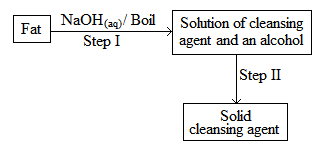
- What name is given to the type of cleansing agent prepared by the method above?(½ mark)
- Name one chemical substance added in step II. (1 mark)
- What is the purpose of adding the chemical substance named in a (ii) above? (1 mark)
- Name any other suitable substance that can be used in step I. (1 mark)
- Explain how an aqueous solution of the cleansing agent removes oil during washing. (2 marks)
- Study the scheme below and answer the questions that follow.
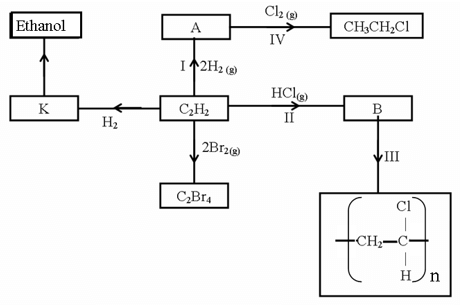
- Identify the catalyst used in step I (½ mark)
- Name the compounds A and B (1 mark)
A…………………………………………….
B……………..…………………………… - Give one disadvantage of compound formed in step III (1 mark)
- Name the reactions taking place at steps: (1 mark)
I…………………………………………
IV........................................................... - Describe how substance K is converted to ethanol (2 marks)
- The scheme below was used to prepare a cleansing agent. Study it and answer the questions that follow.
- The set-up below can be used to generate a gas.
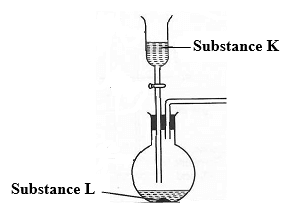
-
- Complete the table below giving the names of substance K and L if the gases generated are carbon (IV) oxide and carbon (II) oxide. (2 marks)
Substance
Carbon (IV) oxide
Carbon (II) oxide
K
L
- Complete the diagram to show how a sample of carbon (II) oxide can be collected. (2 marks)
- State two ways that can be used to distinguish carbon (IV) oxide from carbon (II) oxide? (2 marks)
- Complete the table below giving the names of substance K and L if the gases generated are carbon (IV) oxide and carbon (II) oxide. (2 marks)
-
- In an experiment, carbon (IV) oxide gas was passed over heated charcoal held in a combustion tube. Write a chemical equation for the reaction that took place in the combustion tube. (1 mark)
- State one use of carbon (II) oxide. (1 mark)
- The following set ups were used by Form Two students. Study and use them to answer the questions that follow.
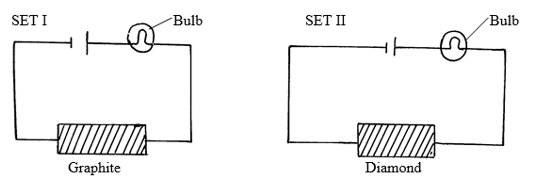
State and explain the difference in observation made in set up I and II above. (3 marks)
-
-
- Define the term solubility. (1 mark)
- In an experiment to determine the solubilities of two salts X and Y at different temperatures, a candidate recorded her observations as shown below.
Temperature (oC)
0
10
20
30
40
50
60
70
80
90
Solubility of X in g/100 g of H2O
14.3
17.4
20.7
25.0
28.5
33.3
40.0
47.0
55.0
64.0
Solubility of Y in g/100 g of H2O
25.0
27.5
30.0
32.5
35.0
37.6
40.1
42.4
45.0
48.0
- On the same axes plot the solubility curves of X and Y. (4 marks)
- From your graph to determine;
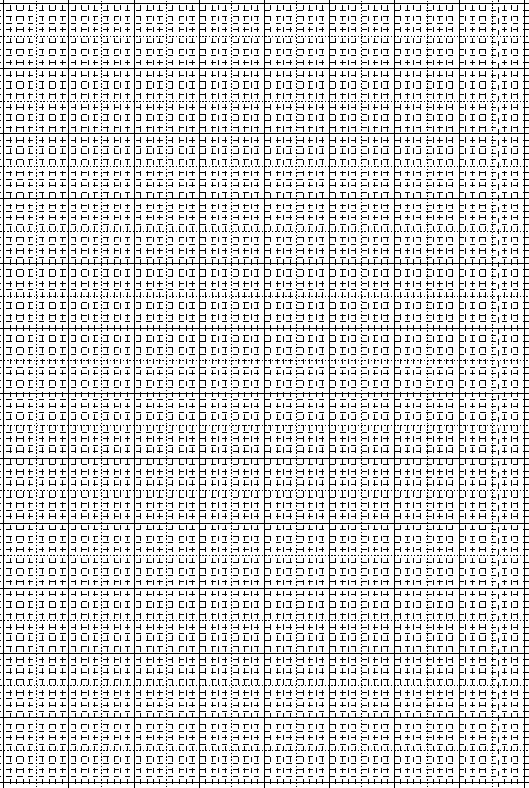
- The solubility of X and Y at 47ºC
Solubility of X (1 mark)
Solubility of Y (1 mark) - The temperature at which the two salts are soluble in water. (1 mark)
- The solubility of X and Y at 47ºC
- If 60g of X is dissolved in 100 g of water and heated to 90ºC, calculate the amount of salt that crystallized out if cooled to 20ºC. (1 mark)
- State what would happen if a mixture salt X in 100 g of water and 30 g of Y in 100 g of water were cooled from 90 oC to 70 oC. (3 marks)
- State one application of solubility. (1 mark)
-
- An ore is suspected to contain Lead metal. Describe the process that can be used to confirm the presence of Lead in the ore. (3 marks)
- The diagram below shows students set-up for the preparation and collection oxygen Gas

- Name substance X used (1mark)
- Write an equation to show the reaction of sodium peroxide with the substance named(1mark)
- Name a two other reagents that can be used to prepare oxygen gas in the laboratory using the apparatus shown above. (1 mark)
- How would you confirm that the gas produced was oxygen. (1 mark)
- Apiece of cleaned magnesium ribbon was burnt in air to form a residue P which was then dissolved in water to form solution Q and a colourless gas R. A blue and red litmus paper was
- State the components of residue P. (1 mark)
- Identify colourless gas R …………………………………………................... (1 mark)
- Write an equation for the formation of solution Q and gas R. (1mark)
- The diagram below shows a set-up of apparatus that can be used to prepare nitrogen (IV) oxide. Study it and use it to answer the questions that follow
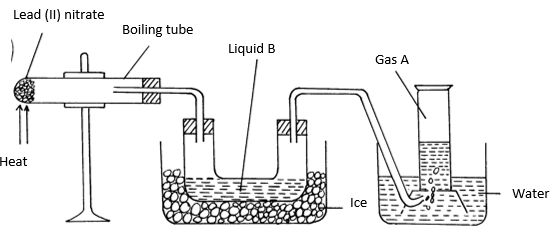
-
- Write the equation for the reaction that takes place in the boiling tube. (1 mark)
- State the observations made in the boiling tube. (2 marks)
- Explain why lead (II) nitrate is preferred over other metal nitrates in this experiment. (1 mark)
- Describe how gas A can be identified. (1 mark)
-
- Name liquid B (1 mark)
- Write a chemical equation to show how liquid B is formed in this experiment. (1mark)
-
- In another experiment, excess aqueous lead (II) nitrate solution was reacted with a solution which contained 2.34g of sodium chloride. Calculate the mass of precipitate formed in this reaction. (Pb = 207, Cl = 35.5, Na = 23) (3 marks)
- Write an ionic equation for the reaction that takes place when nitrogen (IV) oxide reacts with aqueous sodium hydroxide. (1 mark)
-

MARKING SCHEME
- The grid below shows part of the periodic table. Use it to answer the questions that follow. The letters do not represent actual symbols

- Which of the elements has the highest atomic radius? Explain. (2 marks)
Q- √¹This is because it has the highest number of energy levels. √¹
- Identify the most reactive Oxidizing agent. Explain. (2 marks)
U√¹– This is because U has the highest nuclear change due to its small atomic radius among the non metals.
- Compare the atomic radius of P and R. Explain (2 marks)
P has bigger atomic radius than R. This is because P has higher nuclear charge than R. ¹
- Give the formula of one stable ion with an electron arrangement of 2.8 which is:
- A Negatively charged divalent ion. (2 marks)
S2-
- A Positively charged monovalent.
P+
- A Negatively charged divalent ion. (2 marks)
- Given that the mass number of W is 40. Write down the composition of its nucleus. (2 marks)
P = 18 N = 40 – 18 = 28
P = 18P½
N = 22P½
- Write the formula of the compounds formed between.
- Element R and X. (1 mark)
RX2
- Give one property of the structure formed when R and X bond. (1 mark)
- Compounds with the above structures are soluble in water but insoluble in organic conduct.
- Compounds with the above structure conduct electricity in molten and aqueous state but they are non conductors in solid state.
- Compounds with the above structure exist in crystalline form
Compounds with the above structure have very high melting and boiling point. 2
- Element R and X. (1 mark)
- Which of the elements has the highest atomic radius? Explain. (2 marks)
-
- Sodium hydroxide pellets were accidentally mixed with sodium chloride-18.2g of the mixture was dissolve in water to make one liter of solution. 100cm3 of the solution was neutralized by 50cm3 of 0.45M Sulphuric acid.
- Write an equation for the reaction that took place. (1mark)
2NaOH(aq) + H2SO4(aq) → Na2SO4(aq) +22 H2O(l) 1 correct symbols, Balancing - Calculate the;
- Number of moles of the substance that reacted with sulphuric acid. (1 mark)
moles of H2SO4 = 50 × 0.45 = 0.0225
1000
moles that reacted = 0.0225 × 2 = 0.045 - Number of moles of the substance that would react with sulphuric acid in the one litre of solution. (1 mark)
1000 × 0.045 = 0.45
100 - Mass of the unreacted substance in the one litre of solution. (2 marks)
(H = 1.0, Na 23.0, Cl 35.5, 0 = 16.0)
NaOH = 23 + 16 + 1 = 40
0.45 × 40 = 18g
18.2 18 = 0.2g
- Number of moles of the substance that reacted with sulphuric acid. (1 mark)
- Write an equation for the reaction that took place. (1mark)
- The diagram below shows an incomplete set-up used to prepare and collect ammonia gas.

- Name solid P. (1mark)
NH4Cl (s) / any ammonium salt 1 - Complete the diagram to show how a dry sample of ammonia gas can be collected.(3 marks)
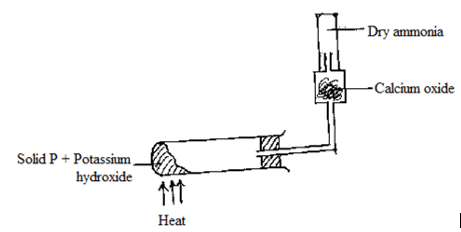
Upward delivery1
Drying agent/Cao1
Workability1
- Name solid P. (1mark)
- In an experiment, excess ammonia gas was passed over heated copper (II) oxide in a combustion tube.
- State the observation that was made in the combustion tube at the end of the experiment. (1 mark)
Brown solid depositedü ½ Colourless droplets on the cool sides. ½ - What property of ammonia is shown in the above reaction? (1mark)
Reducing property/reducing agent. - Give one use of ammonia. (1mark)
- Manufacture of HNO3 1
- Manufacture of ammonium fertilizers.
- Cleansing agent in laundry.
- As a refrigerant in large cold storages.
- State the observation that was made in the combustion tube at the end of the experiment. (1 mark)
- Sodium hydroxide pellets were accidentally mixed with sodium chloride-18.2g of the mixture was dissolve in water to make one liter of solution. 100cm3 of the solution was neutralized by 50cm3 of 0.45M Sulphuric acid.
-
- The scheme below was used to prepare a cleansing agent. Study it and answer the questions that follow.

- What name is given to the type of cleansing agent prepared by the method above?(½ mark)
Soap. ½
- Name one chemical substance added in step II. (1 mark)
Concentrated NaCl/ Brine/ NaCl(l)1
- What is the purpose of adding the chemical substance named in a (ii) above? (1 mark)
To precipitate out the soapa1
- Name any other suitable substance that can be used in step I. (1 mark)
potassium hydroxide/ KOH(aq)1
- Explain how an aqueous solution of the cleansing agent removes oil during washing. (2 marks)
- Cleansing agent is made up of non- polar (hydrocarbon) and polar (head) ½
- When mixed with oil /grease, the hydrocarbon part is attracted to it. ½ while the polar part stays in water ½
- The oil particles are broken and carried off to the solution.1
- What name is given to the type of cleansing agent prepared by the method above?(½ mark)
- Study the scheme below and answer the questions that follow.

- Identify the catalyst used in step I (½ mark)
Uv light
- Name the compounds A and B (1 mark)
A ethane
B 1-chloroethane - Give one disadvantage of compound formed in step III (1 mark)
It is non biodegradable hence causes environmental pollution.any one
- Name the reactions taking place at steps: (1 mark)
I hydrogenation
IV halogenation - Describe how substance K is converted to ethanol (2 marks)
- add concentrated sulphuric (vi) acid to ethane to form ethylhydrogensuplphate
C2H4(g) + H2SO4(l) → C2H5OSO3H(aq)√1 -
add water to the mixture.ethylhydrogensulphate is hydrolysed to ethanol
CH3CH2OSO3H(aq) +H2O(l) → CH3CH2OH(aq) + H2SO4(aq)√1
- add concentrated sulphuric (vi) acid to ethane to form ethylhydrogensuplphate
- Identify the catalyst used in step I (½ mark)
- The scheme below was used to prepare a cleansing agent. Study it and answer the questions that follow.
- The set-up below can be used to generate a gas.

-
- Complete the table below giving the names of substance K and L if the gases generated are carbon (IV) oxide and carbon (II) oxide. (2 marks)
Substance
Carbon (IV) oxide
Carbon (II) oxide
K
Dilute Hydrocloric acid/HCl P½
Ethandioic acid/Methanoic acidP½
L
Calcium carbonate/CaCO3 P½
Conc. H2SO4P½
- Complete the diagram to show how a sample of carbon (II) oxide can be collected. (2 marks)
Overwater nethod P 1, workabilityP 1
NOTE
With ethan dioic pass the gas Potassiun hydroide or Sodium hydroide - State two ways that can be used to distinguish carbon (IV) oxide from carbon (II) oxide? (2 marks)
- Method I
- Pass the gas over lime water 1 forms a white ppt with carbon iv oide ½ and no white ppt with carbon ii oide. ½
-
Method II
-Introduce a burning candle the flame 1 will go off with carbon iv oide ½ and not with carbon ii oxide. ½ -
Method III
-ignite both gases
- Carbon (IV) oxide does not burn/ignite
- Carbon (II) oxide burn with a blue non-sooty flame.
- Method I
- Complete the table below giving the names of substance K and L if the gases generated are carbon (IV) oxide and carbon (II) oxide. (2 marks)
-
- In an experiment, carbon (IV) oxide gas was passed over heated charcoal held in a combustion tube. Write a chemical equation for the reaction that took place in the combustion tube. (1 mark)
CO2 (g ) + C (g) → CO (g) - State one use of carbon (II) oxide. (1 mark)
- In etraction of metals as a reducing agent
- as a fuel in water gas
- In an experiment, carbon (IV) oxide gas was passed over heated charcoal held in a combustion tube. Write a chemical equation for the reaction that took place in the combustion tube. (1 mark)
- The following set ups were used by Form Two students. Study and use them to answer the questions that follow.

State and explain the difference in observation made in set up I and II above. (3 marks)- Bulb lights in step 1 , graphite has delocalized electrons that conducts electricity. ½
- Bulb does not light in step 11 , diamond lacks delocalized electrons. ½
-
-
- Define the term solubility. (1 mark)
Solubility is the maximum mass of solute that dissolves in 100 g of a solvent at a particular temperature.
- In an experiment to determine the solubilities of two salts X and Y at different temperatures, a candidate recorded her observations as shown below.
Temperature (oC)
0
10
20
30
40
50
60
70
80
90
Solubility of X in g/100 g of H2O
14.3
17.4
20.7
25.0
28.5
33.3
40.0
47.0
55.0
64.0
Solubility of Y in g/100 g of H2O
25.0
27.5
30.0
32.5
35.0
37.6
40.1
42.4
45.0
48.0
- On the same axes plot the solubility curves of X and Y. (4 marks)
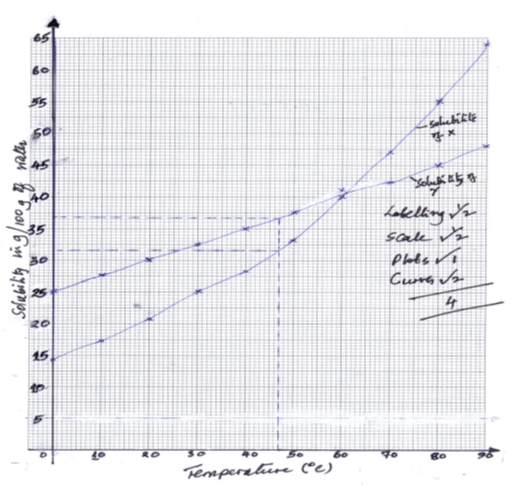
- From your graph to determine;
- The solubility of X and Y at 47ºC
Solubility of X (1 mark)
X:31.5 (±0.2) g/100g of water
Solubility of Y (1 mark)
Y: 36.6 (± 0.2 g/100g of water - The temperature at which the two salts are soluble in water. (1 mark)
60.5 ±1 oC
- The solubility of X and Y at 47ºC
- If 60g of X is dissolved in 100 g of water and heated to 90ºC, calculate the amount of salt that crystallized out if cooled to 20ºC. (1 mark)
60-20.7 =39.3 g - State what would happen if a mixture salt X in 100 g of water and 30 g of Y in 100 g of water were cooled from 90 oC to 70 ºC. (3 marks)
13 g (1 mk) of X will crystallize, salt Y will be in solution (1 mk) . The solubility of X is lower than the mass dissolved while that of N is higher than the mass dissolved.(1 mk)
- State one application of solubility. (1 mark)
Fractional crystallization (any one)
- On the same axes plot the solubility curves of X and Y. (4 marks)
- Define the term solubility. (1 mark)
-
- An ore is suspected to contain Lead metal. Describe the process that can be used to confirm the presence of Lead in the ore. (3 marks)
- Crush the ore to fine powder to increase surface area/reduce particle size. ½
- Add nitric(V) acid to free the ions. ½
- Filter. Retain the filtrate½
- Add excess aqueous ammonia to a sample of filtrate. ½
- A white precipitate insoluble in ecess confirms presence of either Al3+ or Pb2+.½
- Add sodium sulphate,dilute sulphuric(VI)to another portion of filtrate. White precipitate confirms presence of Pb2+. ½
Or
Add potassium iodide to another portion of filtrate.
yellow precipitate confirms presence of Pb2+. - The diagram below shows students set-up for the preparation and collection oxygen Gas

- Name substance X used (1mark)
Water - Write an equation to show the reaction of sodium peroxide with the substance named(1mark)
2Na2O2 (s) + 2H2O(l) → 4 NaOH(aq) + O2(g) P1 - Name a two other reagents that can be used to prepare oxygen gas in the laboratory using the apparatus shown above. (1 mark)
- Hydrogen peroide ½
- Manganese iv oxide ½ - How would you confirm that the gas produced was oxygen. (1 mark)
- Introduce a glowing splint into the gas jar ½
- It rekindles / produces a flame ½
- Name substance X used (1mark)
- Apiece of cleaned magnesium ribbon was burnt in air to form a residue P which was then dissolved in water to form solution Q and a colourless gas R. A blue and red litmus paper was
- State the components of residue P. (1 mark)
- Magnesium oxide ½
- Magnesium nitride ½ - Identify colourless gas R …………………………………………................... (1 mark)
- Write an equation for the formation of solution Q and gas R. (1mark)
Mg3N2 (s) + 6H2O (l) → 3Mg(OH)2 (aq) + 2NH3 (g)
- State the components of residue P. (1 mark)
- An ore is suspected to contain Lead metal. Describe the process that can be used to confirm the presence of Lead in the ore. (3 marks)
- The diagram below shows a set-up of apparatus that can be used to prepare nitrogen (IV) oxide. Study it and use it to answer the questions that follow

-
- Write the equation for the reaction that takes place in the boiling tube. (1 mark)
2Pb(NO3)2(s) 2PbO(s) + 4NO2 (g)+ O2(g)
- State the observations made in the boiling tube. (2 marks)
- brown fumes of NO2
-solid residue is red when hot but on cooling it becomes yellow - Explain why lead (II) nitrate is preferred over other metal nitrates in this experiment. (1 mark)
Lead (II) nitrate crystalises without water of crystalisation that would interfere with the NO2 formed
- Describe how gas A can be identified. (1 mark)
By using a glowing splint. Gas A relights a glowing splint
- Write the equation for the reaction that takes place in the boiling tube. (1 mark)
-
- Name liquid B (1 mark)
dinitrogentetraoxide
- Write a chemical equation to show how liquid B is formed in this experiment. (1mark)
cool
2NO2(q) → N2 O4(l)
- Name liquid B (1 mark)
-
- In another experiment, excess aqueous lead (II) nitrate solution was reacted with a solution which contained 2.34g of sodium chloride. Calculate the mass of precipitate formed in this reaction.
(Pb = 207, Cl = 35.5, Na = 23) (3 marks)
Pb(NO3)2 (aq) + 2NaCl(aq) → PbCl2(s) + 2NaNO3(aq)
1mol → 1mol
117g → 278 g
2.34g → x
x = 2.34 x 378
117
= 5.56g of PbCl2 - Write an ionic equation for the reaction that takes place when nitrogen (IV) oxide reacts with aqueous sodium hydroxide. (1 mark)
2OH-(aq) + Cl2(g) → Cl-(aq) +OCl-(aq) + H2 O(l)
Penalise fully if wrong state symbols or state symbols are missing.
- In another experiment, excess aqueous lead (II) nitrate solution was reacted with a solution which contained 2.34g of sodium chloride. Calculate the mass of precipitate formed in this reaction.
-
Download Chemistry P2 Questions and Answers - Wisdom Pre-Mock Form 4 Exams 2021/2022.
Tap Here to Download for 50/-
Get on WhatsApp for 50/-
Why download?
- ✔ To read offline at any time.
- ✔ To Print at your convenience
- ✔ Share Easily with Friends / Students

